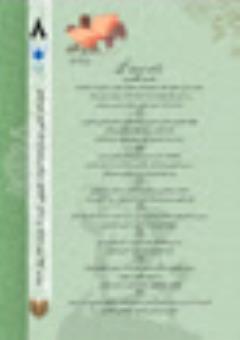A Comparative Study of God's Friendship Signs in Prose Works and Mystical Poems by Mostamli Bokhari and Rumi)
Subject Areas : Comparative Literature Studies
Mostafa KordKatouli
1
![]() ,
maliha mahdavi
2
,
masood mahdian
3
,
maliha mahdavi
2
,
masood mahdian
3
1 - PhD Candidate, Department of Persian Language and Literature, Aliabad Katoul Branch, Islamic Azad University, Aliabad Katoul, Iran.
2 - Department of Persian Language and Literature, Aliabad Katoul Branch, Islamic Azad University, Aliabad Katoul, Iran
3 - Faculty member of Islamic Azad University of Aliabad Katou
Keywords: God, Friendship, Islamic mysticism, Mostamli Bokhari, Rumi, Semiotics.,
Abstract :
The topic of God's friendship is one of the most important and beautiful topics of Islamic mysticism. According to the mystics, the basis of mysticism is based on God's friendship, and the book of "Sharh al-Tarif", one of the most important prose texts and Masnavi Manavi, is one of the most important works of mystical poems, full of concepts related to God's friendship. Mostamli Bokhari, the author of the book "Sharah al-Tarif", measures every action based on love and considers knowledge of the essentials of love necessary for the seeker of the way. Rumi also considers God's love to be one of the main foundations of the right path. Therefore, the purpose of this research is to compare the signs of God's friendship in the works of mystical prose and poetry (Mostamli Bokhari and Rumi). The findings of this research using the analytical descriptive method and the use of library sources showed that claiming the friendship and love of God is not so simple from the point of view of Mostamili and Rumi, and reaching this position requires preparations and necessary preparations. Some of these tools and arrangements are self-knowledge and recognition of the high position of man, struggle with ego, purity of heart, shame and modesty. Mostamli and Rumi further believe that with such signs one can get to know God's true friends. Friends who have indicators such as Remembrance, reliance, not getting angry from calamity, fear, hope and encounter are popular.
References
Books:
1. Holy Quran, (2021). By Osman Taha, Tehran: Andisheh.
2. Nahj Al-Fasahah, (2019). Translated by Ali Akbar Mirzaei, Qom: Parhizkar.
3. Aflaki, A. (2022). Managheb al-Arifin. Tehran: Doostan.
4. Ansari, K. A. (2010). Collection of Persian Letters. Edited by Mohammad Sarwar Molaei, Tehran: Toos.
5. Attar Neishabouri, F. (2019). Tadhkirat al-Awliya. Tehran: Koomeh.
6. Baghli Shirazi, R. (2019). Sharah Shathiyat. Translated by Mohammad Ali AmirMoezzi, Tehran: Tahoori.
7. Ben-Osman, M. (2002). Meftah al-Hedayeh and Mesbah al-Enayeh. By Manouchehr Mozaffarian, Tehran: Farhangestan Zaban & Adabiat Farsi.
8. Boozjani, D. A. (2016). Rouzat al-Riahin. By Hasan Adab Raz & Niaz be Dargah Beiniyaz. Translated by Mohammad Hossein Naeiji, Tehran: Matbooat Dini.
9. Foroozanfar, B. (2023). Commentary on Masnavi Sharif. Tehran, Zavar.
10. Ghazali, A. H. (2014). Ehya Oloum Al-Din. Translated by Moayyed al-Din Kharazmi, Tehran: Ferdos.
11. Hajwiri, A. A. (2014). Kashf al-Mahjoob. By Mahmoud Abedi, Tehran: Soroush.
12. Jam, A. (1990). Montakhab Seraj Al-Saerin. Mashhad: Astan Ghods Razavi.
13. Jami, A. (2010). Margha NeiNameh. By Mozaffar Bakhtiar, Tehran: Markaz Nashr Daneshgahi.
14. Khomeini, R. (2021). Adaab al-Salah, Qom: Institute for editing and publishing the works of Imam Khomeini.
15. Meybodi, R. A. (2014). Kashf al-Asrar & Eddat al-Abrar. By Ali Asghar Hekmat, Tehran: Amir Kabir.
16. Mihani, M. M. (2021). Asrar al-Toheed fi Maqamat al-Sheikh Abi Saeid. By Mohammadreza Shafi'i Kadkani, Tehran: Aghaz.
17. Molla Sadra, S. (2009). Erfan VA Erfan Namayan Namayan. Translated by Mohsen Bidarfar, Tehran: Al-Zahra (S).
18. Mostamli, A. E. (1392), Sharh al-Tareef of Sufism. By Mostafa Amiri, Tehran: Miras Maktoob.
19. Naraghi, M. A. (2021). Mearaj al-Saadah. By Kazem Abedini Motlagh, Tehran: Jamal.
20. Nasafi, A. (2020). Al-Ensan al-Kamal. Translated by Seyyed Ziauddin Dehshiri, Tehran: Tahoori.
21. Qomi, S. A. (2005). Koliyat Mafatih al-Jannan. Translated by Mahdi Elahi Qomshaei, Qom: Umm Abiha.
22. Raz Shirazi, A. G. (2008). Menhaj Anwar al-Maarafah fi Sharh Mesbah al-Shari'a. By Seyyed Mohammad Jafar Bagheri, Tehran: Khanghah.
23. Rumi, J. (2018). Masnavi Manavi. Tehran: Parmis.
24. Tabatabaei, M. H. (2017). Majmooe Resael. By Seyyed Hadi Khosroshahi, Qom: Bootsan Ketab.
Articles:
1. Amin, A., & Raeisi Nafchi, R. (2018). A comparative study of the biography of Ahl al-Bayt (PBUH) in the description of the identification of Sufism by Mostamil Bokhari and Tadhkirat al-Awliya Attar. Imam Ali ΄s Studies, 9(18), 1-28.
2. Asghari, T., Mahdavi, M., & Mahdian, M. (2023). Sociological Investigation of Rumi's Complaints in Masnavi-ye-Ma'navi with Emphasis on Three Main Themes. Jostarnameh Journal of comparative Literature Studies, 6(22), 86-117.
3. Forughi Moghaddam, B., & Eje’ee, T. (2019). The Educational Approach of Sharh at-Ta'arrof to the Story of Prophet Adam (PBUH) in the Qur'an. Literary Arts, 11(2), 37-50.
4. Mohammadi, M., Saffari, M., & Samizadeh, R. (2021). Narrative; One of the style traits in Sharh-e Taaruf. Journal of Stylistic of Persian poem and prose, 13(10), 103-123.
5. Pazhouhandeh, L. (2013). The Affinity between God and Man in Teleological and Mystic Literature: The Case of Mowlavi. Journal of Adab Pazhuhi, 6(22), 97-124.
6. Yamini, P., Ahmadnezhad, K., Mohseni Hanjani, F., & Latifi Azimi, A. (2021). The intellectual approaches of Rumi and Arvinialum to the category of fear. Jostarnameh Journal of comparative Literature Studies, 5(15), 28-58.


